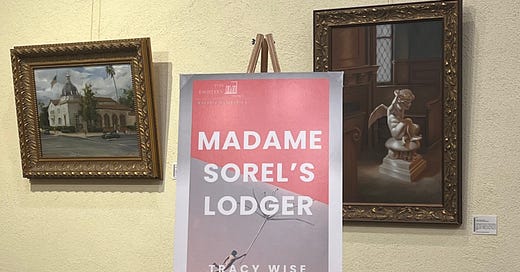Hop on the struggle bus!
-How I learned about mental, national and personal struggle in one week.
A writing exercise made Tracy Wise a published author.
Join me this week in pondering the many ways us humans ‘like’ to struggle -from a troubled artist to the civil war and having a middle aged body.
In “Madam Sorel’s Lodger” you can tell that Wise thought about the mental anguish and final days of one of the last century’s best known artists, Van Gogh. I was utterly fascinated by how Wise had grabbed on to a famous person and begun writing an utterly fictionalized version of his life. No research necessary, just pure imagination.
A.K. Smiley Public Library had partnered with our local independent bookstore, The Frugal Frigate and invited Wise to present her very first published novel Wednesday night. A dream for the best of us local writers.

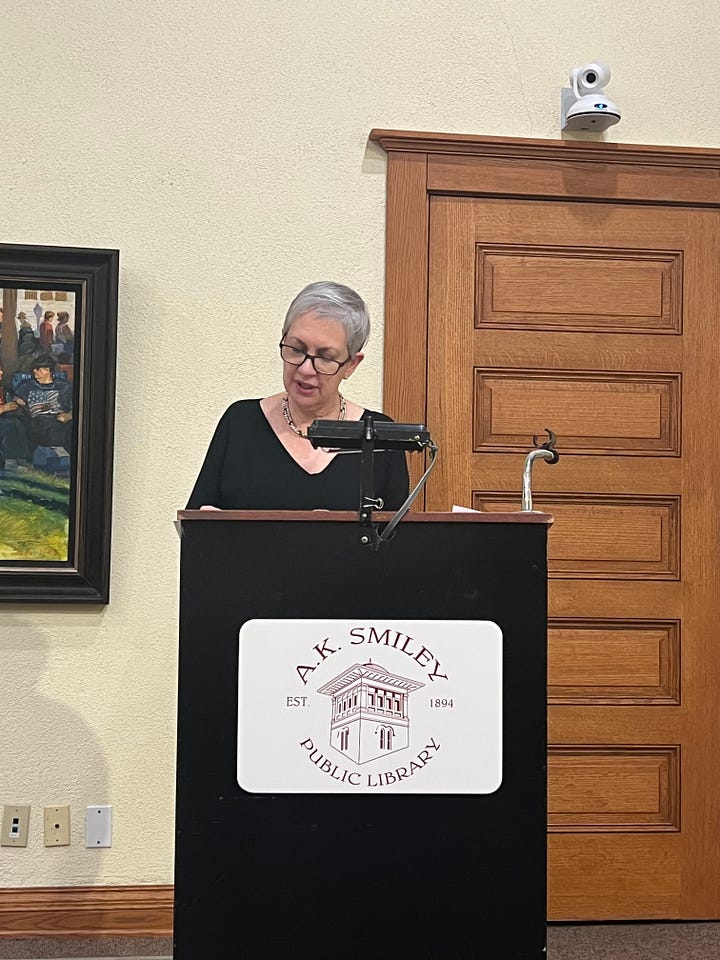
“You are my Redlands,” Wise said looking over the crowd in the Assembly Room. All the chairs had been taken, we were at least fifty people in there.
When she talked about being on a writing retreat cruise my ears perked up. There she was on a boat writing this short story about Van Gogh in a week, the story would eventually become a full novella. She did no deliberate research, but thought about what she already knew and had absorbed about the artist. “Everybody knows Van Gogh’s painting of sun flowers,” she said.
Once many years ago she had visited a museum and gotten four postcards of Van Gogh paintings she had never seen before. The postcards hung in her home for 25 years and those were the basis for the story.
Van Gogh lived a troubled life in and out of mental institutions. So too, do we readers dive into his troubled mind in Wise’s book. In Wise’s version Van Gogh is visiting a little village in France and becomes friends with the local community.
“This is a story about community as much as a story about an individual,” Wise said.
And as I read the story and learn of the ways Wise imagines Van Gogh struggle in life, she also creates a little period of respite and peace for him. In the village of A- he learns that life becomes better when he connects with others, when he leans into trust and find positive outlets for his manic creativity. Unfortunately, the trust is broken (you’ll have to read the book to know more) to the detriment of not only the troubled artist but to the people who care about him. Wise also spins an alluring new take on his final demise that I absolutely loved.
One of the most fascinating details was how Wise described Van Gogh’s final painting depicting an olive tree grove. Afterwards she learned that trees had in fact played a role in his final work. Did her muse know or was it serendipity?
Wise finished her first draft in 2017, eight years later it got published (by Type Eighteen Books, a small press in Orange County). The publishers were there supporting the event. And Erin from The Frugal Frigate said it was the first author event she had done where all the books sold out.
What I learned from reading Wise’s book was that community can save us, if we will let it.

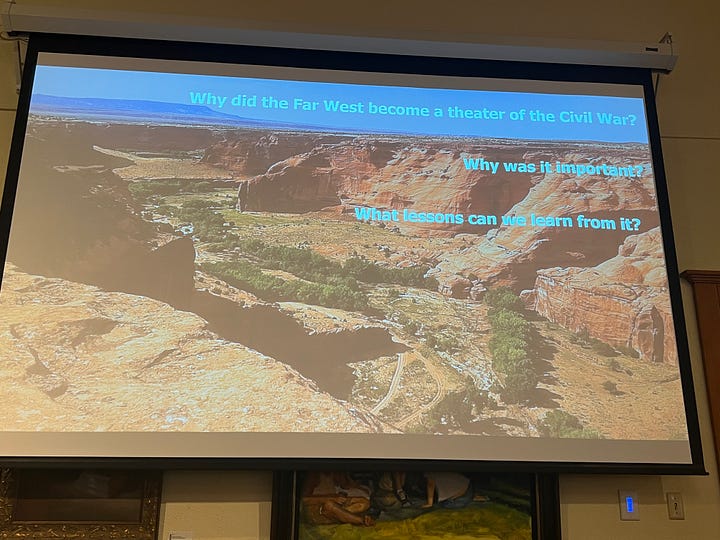
On Saturday I pivoted back into the stories of struggles as I returned to the Assembly Room at A.K. Smiley Public Library. This time 100 chairs were full of people (mostly older men which will make sense in the next sentence). The talk was by PhD historian Megan Kate Nelson who talked about her latest book on “The American Civil War in the Desert Southwest.”
The picture Nelson painted of the civil war was with broad paint strokes and an impressive amount of details thrown into the mix. In her book she attempts to tell history through nine individuals. Not only did she use military personnel but also indigenous women, wives, civilian and political figures.
What I learned was that the confederacy tried to conquer the West all the way to the Californian coast in order to have important harbor ports and even more so access to gold mines. Luckily through a fully inept strategy of logistics and no understanding of history their plans didn’t pan out.
Another thing I loved about the presentation, was the way Nelson researched for the book as an environmental historian doing on sight research, visiting the places today where history took place. Connecting local places to the historic facts.
She also steeped herself in civilian John Clarks 25 volumes of diaries from 1861-1867 plus his weekly letters to the general land office. “I was delighted to go to the national archives and find this huge box just stuffed with all of the letters, all of the maps that he sent back to the general,” Nelson said. “This is a plan of Santa Fe. He mapped Santa Fe and sent it to the general land office, and those creases are pristine. I am convinced I am probably the third person to look at it.”
“A clerk opened it, put it somewhere. And then an archivist took it out and looked at it. And then me,” she said. “It’s a really interesting source base for this period.”
Other lessons from the failed expansion of the Confederacy was understanding where the natural resources would be, that the distances were so long and war is hard.
Another point was understanding that the civil war in the far West was also an Indian war which she later exemplified by mentioning the greatest mass hanging of the Dakota people that happened in US history in 1862. “Their whole goal was to either absorb native people into their societies or push them away and segregate them onto reservation where ultimately they could be converted to ‘real’ Americans,” she said. On a side note she mentioned another meaner strategy was to starve the natives to death.
Ultimately the US were victorious over the Confederates. Competence ultimately won over incompetence (worth remembering these days). This nation survived the ultimate struggle by one side being smarter and stronger. And with the ability to pass important legislature like the Homestead Act and the first of two Pacific Railroad Acts which changed history for the white settlement of the West, Nelson explained.
Fun facts: Camels were brought to California then at a military base in Fort Tejon, we had camels at one point!
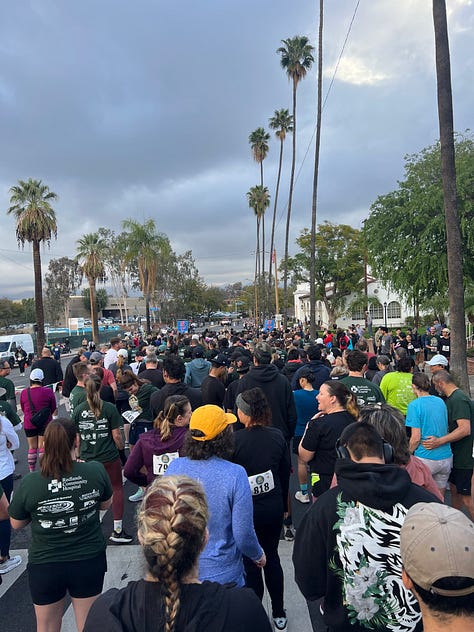

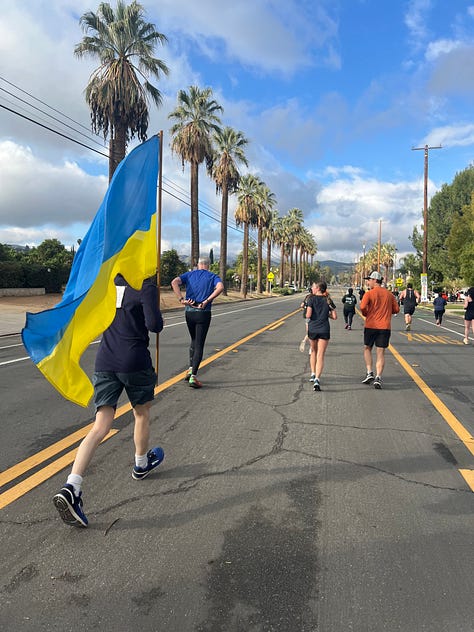
Finally, Sunday morning thousands of Redlanders and other locals tied their running shoes and ran the 42nd Annual A Run Through Redlands. Because of a persistent hip issue and general ‘taking a pause from running’ I had barely gotten out on the streets leading up to the race.
A fellow Dane and current exchange student convinced me to run the 5K with her. I thought, I can do a 5K, this teen will probably run ahead but it’s fine. If need be I can walk.
It has been 16 years since I ran my first and only 5K at A Run Through Redlands. That was the beginning of my running ‘career’ when the instructors at our local chapter of Baby Bootcamp convinced me to sign up. Since then I don’t think I’ve missed a race. For a while I ran the Half Marathon but mostly I’ve stuck to the 10K.
And oh my, the 5K is the most dense and packed race of them all. At the starting line we were standing shoulder to shoulder. I told Filippa, “We just gotta make sure not to start out too hard.” And then we proceeded to run way faster than my regular speed.
I looked at my watch and thought, oops. But then the excitement and all of the throngs of fellow runners kept us going. The adrenaline kicked in. I knew the route. The struggle came at the last mile, my legs were feeling heavier and heavier. At that point I was ready to dig in and not pay attention to the level it took me to stay the pace.
Struggle. This constant companion in life, whether you are a struggling mentally as an artist or struggling in a civil war, what strengths pull you through?
For me I understood that keeping a run streak for 3.5 years, for having run consistently for over a decade, my muscle memory was there - I could run three miles fast (for my body). I had put in the work years prior. Personally my struggle came in the following days when my legs felt like pillars of concrete yelling at me, “What have you done?” Totally worth it. Thanks to Filippa, together we did it.
Nothing is done in loneliness. True conquer happens in community.
I hope you enjoyed my take on struggles. If you or anyone you know struggles these days, remind them to join their local community to find supportive events.
Thank you for reading. If you enjoyed this piece, please like below and subscribe to my Substack: www.siwheede.substack.com
And why not tell your friends and family to follow along? Please share.

